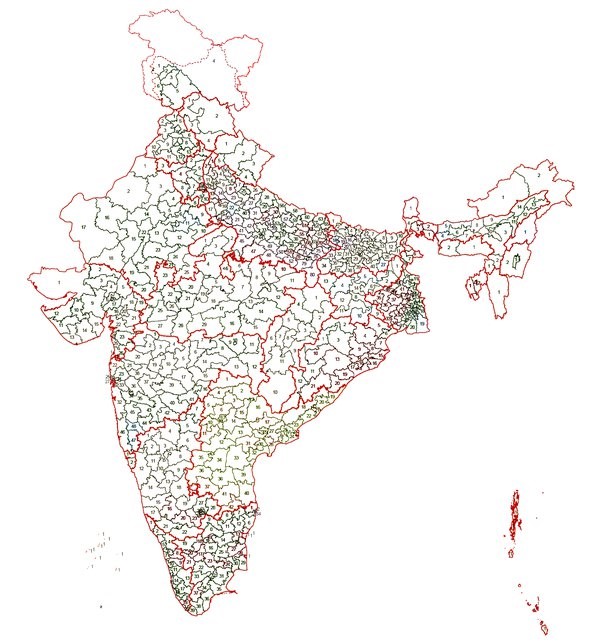Description

Disclaimer: Copyright infringement not intended.
Context
- The delimitation of constituencies for the Lok Sabha and State Legislative Assemblies is to be carried out on the basis of the first Census after 2026.
- The 2021 Census was originally postponed due to the COVID-19 pandemic and subsequently due to delays on the part of the Central government.
What is Delimitation?
- Delimitation refers to fixing the number of seats and boundaries of territorial constituencies for the Lok Sabha and Legislative assemblies.
- It includes determining seats reserved for Scheduled Castes (SC) and Scheduled Tribes (ST).
- Article 82 and 170 of the Constitution mandate readjustment of seats after each Census, performed by the Delimitation Commission.
- Delimitation involves establishing boundaries for electoral constituencies based on population changes within a country.
- The process aims to ensure fair representation by dividing geographical areas into constituencies.
Constitutional Requirement:
- Democracy necessitates representation based on the principle of 'one citizen-one vote-one value'.
- The number of Lok Sabha seats was frozen as per the 1971 Census to promote population control measures.
- Seats were redistributed after the 2001 Census, and will be readjusted post-2026 Census.

Independence of the Delimitation Commission
- The Delimitation Commission operates autonomously, free from executive influence.
- Its decisions are final and cannot be challenged in court, preventing delays in elections.
- Once presented, the orders of the Commission to the Lok Sabha or State Legislative Assembly remain unalterable.
Objectives of Delimitation
- Equitable representation for all segments of the population, adhering to the principle of "One Vote One Value."
- Preventing any single political party from gaining an unfair advantage through constituency delineation.
Composition of the Delimitation Commission
- Appointed by the President of India in collaboration with the Election Commission of India.
- Members include retired Supreme Court judges, the Chief Election Commissioner, and State Election Commissioners.
Process of Delimitation
- Initiated through the enactment of a Delimitation Act by Parliament after each Census.
- States also undergo division into territorial constituencies according to this Act.
- The Union government establishes a Delimitation Commission to carry out the delineation.
Historical Context
- Delimitation exercises have occurred in various years, notably in 1950-51, 1952, 1963, 1973, and 2002.
- Exceptions exist, such as after the Censuses of 1981 and 1991.
Issues Surrounding Delimitation
- Concerns arise regarding states with lax population control policies potentially gaining an undue number of parliamentary seats.
- Discrepancies occur when delimitation is based on a recent census while the total number of seats remains determined by an older census.
- Constitutional limits on the number of Lok Sabha and Rajya Sabha seats may result in increasing populations being represented by a single representative.
- Uneven population growth across states poses challenges in delimitation.
- Options for delimitation based on projected 2026 population are debated, with implications on representation and federal principles.

International Practices:
- In the U.S., seats in the House of Representatives are capped and redistributed after each Census.
- The EU Parliament follows 'degressive proportionality', increasing seats with population growth.
Ideal Solution:
- Reconciling democratic and federal principles is crucial.
- Maintaining the current number of Lok Sabha seats while adjusting state-level representation ensures continuity and upholds federalism.
- Strengthening local governance through empowerment of panchayats and municipalities is essential for grassroots democracy.
|
PRACTICE QUESTION
Q. Consider the following statements regarding the Delimitation exercise in India:
- The Delimitation Commission is responsible for fixing the number of seats and boundaries of territorial constituencies for the Lok Sabha and Legislative assemblies.
- The decisions of the Delimitation Commission are subject to judicial review, allowing courts to modify or overturn them if deemed necessary.
- The primary objective of Delimitation is to ensure unequal representation, favoring certain political parties over others in elections.
- The Delimitation Commission is composed of members appointed by the Prime Minister of India in consultation with the Chief Justice of India.
Which of the above statements is/are incorrect?
A) 1 and 4 only
B) 2, 3 and 4 only
C) 3 only
D) All
Answer: B) 2 only
Explanation:
- Statement 1 is correct. The Delimitation Commission is indeed responsible for fixing the number of seats and boundaries of territorial constituencies for the Lok Sabha and Legislative assemblies. This is in line with the purpose of delimitation, which aims to ensure fair representation based on population changes.
- Statement 2 is incorrect. The decisions of the Delimitation Commission are not subject to judicial review. They are final and cannot be questioned before any court, as explicitly mandated by the Constitution. This is to prevent delays in the electoral process and ensure the independence of the Commission.
- Statement 3 is incorrect. The primary objective of Delimitation is to ensure equal representation for all segments of the population, adhering to the principle of "One Vote One Value." It aims to prevent any single political party from gaining an unfair advantage through constituency delineation.
- Statement 4 is incorrect. The Delimitation Commission is not composed of members appointed by the Prime Minister of India. Instead, it is appointed by the President of India in consultation with the Election Commission of India. The Commission typically comprises retired Supreme Court judges, the Chief Election Commissioner, and State Election Commissioners.
Therefore, the correct answer is B) 2, 3 and 4 only.
|














